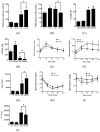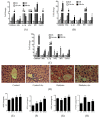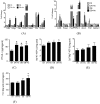Arsenic induces diabetic effects through beta-cell dysfunction and increased gluconeogenesis in mice
- PMID: 25367288
- PMCID: PMC4219158
- DOI: 10.1038/srep06894
Arsenic induces diabetic effects through beta-cell dysfunction and increased gluconeogenesis in mice
Abstract
Arsenic as a potential risk factor for type 2 diabetes has been received attention recently. However, the roles of arsenic on development of diabetes are unclear. In this study, we compared the influences of inorganic arsenic (iAs) on normal and diabetic mice by systems toxicology approaches. Although iAs exposure did not change glucose tolerance in normal mice, it caused the pancreatic β-cell dysfunction and increased gluconeogenesis and oxidative damages in liver. However, iAs exposure worsened the glucose tolerance in diabetic mice, which might be due to increased gluconeogenesis and impairment of pancreatic β-cell function. It is interesting that iAs exposure could improve the insulin sensitivity based on the insulin tolerance testing by the activation of glucose uptake-related genes and enzymes in normal and diabetic individuals. Our data suggested that iAs exposure could cause pre-diabetic effects by altering the lipid metabolism, gluconeogenesis and insulin secretion in normal individual, and worsen diabetic effects in diabetes individual by these processes. Insulin resistance might be not the reason of diabetic effects caused by iAs, indicating that mechanism of the diabetogenic effects of iAs exposure is different from the mechanism associated with traditional risk factors (such as obesity)-reduced type 2 diabetes.
Figures







References
-
- Zimmet P., Alberti K. G. & Shaw J. Global and societal implications of the diabetes epidemic. Nature 414, 782–7 (2001). - PubMed
-
- Hectors T. L. M. et al. Environmental pollutants and type 2 diabetes: a review of mechanisms that can disrupt beta cell function. Diabetologia 54, 1273–1290 (2011). - PubMed
Publication types
MeSH terms
Substances
LinkOut - more resources
Full Text Sources
Other Literature Sources
Medical

